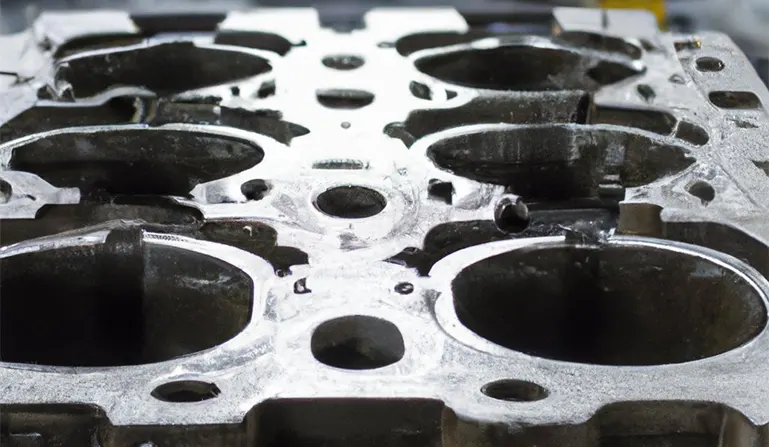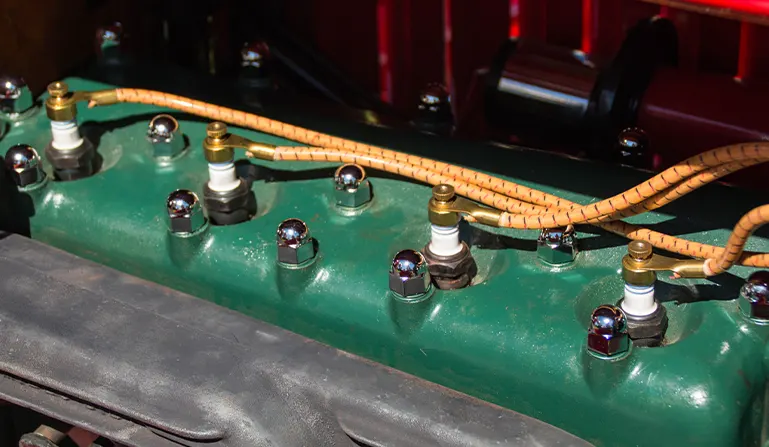Cylinder heads provide compression and house engine valves in your car. Understanding the cylinder head in your car and its role in the engine’s performance and efficiency, this article will cover everything you need to know about cylinder heads.
What is a cylinder head?
The cylinder head is a key part of the engine, sitting at the top and helping it run smoothly. It works like a lid for the engine’s combustion chamber, which is where the fuel gets burned to make power.
The cylinder head has a big job of managing the air and fuel that go into the engine and letting out the burnt gases after. It’s made to be sturdy and can be made of materials like cast iron or aluminum.
Inside the cylinder head, you’ll find important parts like valves, which control air and fuel flow, and spark plugs, which help ignite the fuel. It also has special paths for oil and coolant to keep the engine lubricated and cool.
So, the cylinder head is like the manager of air, fuel, and waste in the engine, making sure everything flows where it should.

What is the head gasket?
When the cylinder head closes the combustion chamber, there is a gap between the cylinder head and the engine. It is sealed by another part of the engine, namely, the head gasket.
Its primary function is to prevent engine oil and coolant from leaking into each other’s spaces, and to prevent combustion gases from escaping into the coolant passages. The head gasket also helps maintain proper compression and prevent engine overheating.
Different Types of Cylinder Heads
| Type | Description | Advantages |
| Flathead | Simple, one-piece design with valves in the engine block and on the sides. | Easy and less costly to make; allows coolant to flow effectively, is lightweight, and compact. Used in old cars. |
| Overhead Valve (OHV) | Complex design with valve train components, spark plugs, and intake/exhaust ports within the head. | Improved engine performance with faster and smoother gas flow, efficient exhaust ports, and simplified timing/drive systems. |
| Overhead Camshafts | Most advanced design with camshaft also located in the head. | Higher power and efficiency; superior performance with dual OHC heads. |
Below image shows a Flathead Cylinder Head of a car engine.

How many cylinder heads does a car have?
The number of cylinder heads in a car can vary based on the engine design. Typically, cars with inline engines (where cylinders are arranged in a single line) have one cylinder head. However, vehicles with V-type engines (where cylinders are arranged in a V shape) usually have two cylinder heads, one for each bank of cylinders.
What are the five functions of the cylinder head?
- Sealing the Combustion Chamber: The cylinder head forms the top of the combustion chamber, ensuring the high-pressure gases from combustion are contained.
- Controlling Airflow: It manages the intake of air and fuel and the expulsion of exhaust gases through valves.
- Facilitating Combustion: Housing spark plugs, it aids in igniting the air-fuel mixture, initiating combustion.
- Cooling the Engine: With coolant passages, it helps regulate engine temperature by directing coolant through the engine.
- Lubricating Components: It allows oil to flow through, ensuring lubrication of moving parts like valves and camshafts.
How do cylinder heads affect performance?
Cylinder heads significantly influence engine performance by controlling the airflow and facilitating efficient combustion. A well-designed cylinder head ensures optimal air and fuel mixture, effective heat dissipation, and smooth exhaust gas expulsion. It impacts:
- Power Output: Ensuring efficient combustion, which generates power.
- Fuel Efficiency: Managing air-fuel mixtures for optimal burning.
- Cooling: Aiding in maintaining the engine’s thermal balance.
- Emissions: Influencing the cleanliness of exhaust gases.
Why Do Cylinder Heads Fail?
Cylinder heads can fail for several reasons, including:
- Overheating: Overheating can cause warping, cracking, and other damage to the cylinder head. As a result, the cylinder head will not seal properly.
- Poor Maintenance: If you neglect regular engine maintenance and fail to replace worn-out components, the engine will fail to function.
- Engine Design Flaws: Some engine designs can be prone to cylinder head failure due to inherent design flaws, such as poor oil or coolant flow or weak head bolts.
- Improper Installation or Modification: When the engine components are modified and reinstalled, it needs to be done properly. Otherwise, the cylinder head will fail to function.
- Engine Wear and Tear: Over time, normal wear and tear can cause components like the head gasket to fail, leading to damage to the cylinder head.
How do I know if my cylinder head is bad?
Identifying a bad cylinder head involves observing several symptoms:
- Overheating: Persistent engine overheating may indicate a problem.
- Coolant Leaks: Visible leaks or low coolant levels can be a sign.
- Poor Performance: Noticeable drops in power or fuel efficiency.
- Smoke: Excessive smoke from the exhaust might indicate a damaged head.
- Misfires: Engine misfires or trouble starting can be related to cylinder head issues.
How to check if you need to replace or repair your cylinder head?
Several signs indicate that your cylinder head may need to be replaced or repaired:
| Signs of Cylinder Head Issues | Possible Causes |
| Overheating engine | Blown head gasket or damaged cylinder head |
| Engine misfire or power reduction | Damaged the or warped cylinder head |
| Leaking fluids around the cylinder head | Damaged head gasket or crack in the cylinder head |
| White smoke from the exhaust | Coolant mixing with the combustion process, indicating a head gasket or cylinder head problem |
| Engine oil contamination | Milky substance in engine oil, indicating damaged head gasket or cylinder head |
How to Install a Cylinder Head?
Installing a cylinder head is a meticulous process that demands precision to ensure optimal engine performance. Here’s a simplified guide:
- Prepare the Engine: Begin by ensuring the engine is cool, disconnecting the battery, and removing the engine cover and other components obstructing access to the cylinder head.
- Remove the Old Cylinder Head: Detach the exhaust manifold, intake manifold, and other connected components, and then carefully remove the old cylinder head.
- Clean and Inspect: Thoroughly clean the engine block surface and inspect it, along with the new cylinder head, for any damage or warping.
- Place the New Head Gasket: Position the new head gasket on the engine block, ensuring it aligns with all necessary holes and passages.
- Install the New Cylinder Head: Carefully place the new cylinder head onto the engine block, aligning it accurately with the gasket and block.
- Secure the Cylinder Head: Gradually tighten the cylinder head bolts in the specified sequence and to the torque specified in your vehicle’s manual.
- Reattach Components: Reconnect the exhaust manifold, intake manifold, and any other components that were removed.
- Reconnect the Battery: Ensure all connections are secure and reconnect the battery.
- Test: Start the engine and check for leaks or issues, ensuring the installation was successful.
Ensuring a precise installation is paramount to avoid leaks and ensure efficient engine operation. While the steps provide a general guide, always refer to the specific vehicle model’s manual for detailed instructions and adhere to all safety precautions.
According to the complexity of the task, professional assistance might be advisable to ensure accurate installation and to maintain the integrity of the engine.
How to choose a Right Cylinder Head for Your Car
Here’s a detailed guide to help you make an informed decision:
Understand Your Vehicle’s Requirements
- Engine Type: Identify your engine type (e.g., inline, V-type) to determine the compatible cylinder head.
- Vehicle Use: Consider whether your car is used for daily driving, racing, or towing, as different activities may require different cylinder head specifications.
Material Consideration
- Aluminum vs. Cast Iron: Aluminum heads are lighter and offer better heat dissipation, while cast iron heads are durable and less expensive.
Valve Considerations
- Valve Size: Larger valves allow more air and fuel into the cylinder, enhancing performance, but require adequate cylinder head volume to avoid flow issues.
- Valve Material: Consider durable materials like stainless steel or titanium for valves, especially for high-performance applications.
Port and Chamber Design
- Port Size: Opt for a port size that complements your engine’s capacity and intended use to ensure efficient air and fuel flow.
- Combustion Chamber: The size and shape of the combustion chamber influence compression ratio and airflow, affecting power and efficiency.
Compatibility with Existing Components
- Camshaft Compatibility: Ensure the cylinder head is compatible with your camshaft, considering aspects like lift and duration.
- Intake and Exhaust Manifold Fit: Ensure the new head aligns with your intake and exhaust manifolds to avoid leaks and performance issues.
Manufacturer and Brand
- Reputable Brands: Opt for cylinder heads from reputable manufacturers to ensure quality and durability.
- Warranty: Consider brands that offer warranties or guarantees on their products for added peace of mind.
Professional Consultation
- Expert Advice: Seek advice from mechanics or experts who can guide you based on your specific vehicle model and usage.
- Installation: Consider professional installation to ensure accurate fitting and optimal performance.
Budget
- Cost vs. Quality: While staying within budget, prioritize quality to avoid future issues and additional costs.
- Investment: View the cylinder head as an investment in your vehicle’s performance and longevity.
Choosing the right cylinder head involves a blend of understanding your vehicle, recognizing the role of various components, and aligning your choice with your driving needs and budget. Always prioritize quality and compatibility to ensure that the new cylinder head enhances your vehicle’s performance and reliability.
And remember, when in doubt, consulting a professional is always a prudent step to ensure accurate selection and installation.
Summary
In conclusion, the cylinder head is a crucial component of a car’s engine and plays a key role in engine performance and efficiency. Proper maintenance and selection of a high-quality cylinder head can enhance your driving experience and improve the longevity of your engine.

John Smith, a Los Angeles-based car specialist and automotive writer, boasts over 20 years in the industry. With a background as a master technician and a decade-long writing stint at notable automotive publications, John now shares his expansive knowledge on CarFinite, simplifying car maintenance for readers.

